It's an unusually cool and rainy day here; a good time to catch up the blog. I'm sitting here in the motorhome, our 3-foot tall Christmas tree surrounded by presents and glowing brightly, holiday shows on the TV, and enjoying a cup of coffee. Brenda's finishing up a marvelous coconut macaroon cheesecake, and the cat is sleeping (big surprise). We're getting close to moving again, but before we do we'd like to share our travels here in San Antonio. As usual, our trips are defined by restaurants; here in San Antonio our favorite for lunch is Schilo's, a downtown deli for over 80 years that is listed in the Mobile guide and voted one of San Antonio's 10 best. It's an old building with old furniture and a great German menu. Brats, wurst, rye bread, and home made pea soup....with homemade root beer; all for under 10 bucks. If you travel to the Rivercenter Mall, look it up, it's right across the street. Another of our favorites is Rudy's Bar-B-Que, a local chain where you order your ribs by the pound. Great stuff, and cheap! In between eating, we managed to visit a few places also. After visiting the Alamo again, we decided to explore another of the "chain of missions" that follow the San Antonio river south. The largest, Mission San Jose, has a great visitor center and has been restored to its original size and condition.  Since the perimeter wall is the same size as the Alamo's was, (about a city block) it's easy to see how it would be impossible to defend with less than 300 men. We thought it interesting that a Catholic mission, still in use, is managed by the US Park Service, a government agency. Also interesting was the granary, a reproduction of the original water-driven mill.
Since the perimeter wall is the same size as the Alamo's was, (about a city block) it's easy to see how it would be impossible to defend with less than 300 men. We thought it interesting that a Catholic mission, still in use, is managed by the US Park Service, a government agency. Also interesting was the granary, a reproduction of the original water-driven mill.  The Spanish missionaries and soldiers would not eat corn flour, so the mill only ground wheat for their bread, and the millstones (still in use) were imported from France. So we end up with a stone from France grinding wheat for their enemy the Spanish in a country where everyone eats corn.
The Spanish missionaries and soldiers would not eat corn flour, so the mill only ground wheat for their bread, and the millstones (still in use) were imported from France. So we end up with a stone from France grinding wheat for their enemy the Spanish in a country where everyone eats corn.
Brenda's love of animals always makes the local zoo a "must see", and the San Antonio zoo is one of the best we've  been to. It helped that it was a marvelous day, high 70s and sunny; and with everyone else out shopping we had the place to ourselves.
been to. It helped that it was a marvelous day, high 70s and sunny; and with everyone else out shopping we had the place to ourselves. 

The highlight of our visit was when a Lory decided that Brenda's hair would make a good nest and decided to make itself at home. It would have been interesting if she could have brought her new "hat" home and let the cat have a look, assuming it could stay awake long enough to notice.
Somehow we're always too busy to see all the sights on our list and have to move on, so after a Christmas Eve dinner (Brenda's making Zele and Knedlicky - Roast pork and potato dumplings for you non-bohemians) with our full-time friends Dennis and Ann, and a Christmas Day dinner with our friends Tom and Janet we'll be heading west. Thank you all for the holiday wishes, we feel so lucky to have so many friends in so many places. We wish you all the best this year and next, and hope that like us, you can live your dream. Happy Holidays!
Sad to say, we left the Brazoria refuge after a little over three weeks of battling mosquitoes and being kept prisoners in our motor home. While we were told by the volunteer coordinator to expect mosquitoes, we weren't prepared to deal with the huge numbers day and night. Because the volunteer RV park was located on the refuge and near the water, the nasty bugs swarmed around us continually.....let me take you to a typical night returning to the coach: 1) I get out of car, make mad dash to unlock coach door; 2) I pick up can of mosquito fogger and create "fog corridor" from door to Brenda's door on car; 3) Brenda and I make mad dash back to coach spraying madly as we go; 4) once inside, we spend another hour tracking down bugs that followed us inside (the Dustbuster vacuum works great!). Along with the mosquitoes, the area was infested with fire ants, venomous snakes (saw two rattlesnakes), and, of course, alligators. All in all, it wasn't enjoyable and while the people were great to work with, we realized that we were not enjoying ourselves any longer, and so, after 88 volunteer hours each, we advised them that we were going to move on.  They were gracious and understanding; I'm sure this happens often in such a hostile environment. I knew I was in trouble when these two vultures kept following me around every day waiting for the blood loss to slow me down. We have the greatest respect for the US F&W staff that work everyday under these conditions; but the difference is that they went home to a relatively bug-fee area each night. We wish them well but have learned a valuable lesson - do more research on an area that we're interested in visiting.
We're now in San Antonio at a nice park that we stayed at last year. It's conveniently located near I-35 and the "loop", and we're only 15 miles to the Riverwalk, one of our favorite places to
They were gracious and understanding; I'm sure this happens often in such a hostile environment. I knew I was in trouble when these two vultures kept following me around every day waiting for the blood loss to slow me down. We have the greatest respect for the US F&W staff that work everyday under these conditions; but the difference is that they went home to a relatively bug-fee area each night. We wish them well but have learned a valuable lesson - do more research on an area that we're interested in visiting.
We're now in San Antonio at a nice park that we stayed at last year. It's conveniently located near I-35 and the "loop", and we're only 15 miles to the Riverwalk, one of our favorite places to visit. Here we met with our friends Trixie and Bob, who are on their shakedown cruise of a new motorhome. We spent a wonderful evening at a riverwalk restaurant during the annual lighting ceremony and Xmas parade. Our table overlooked the river and gave us a great (and relaxing) view of the events while wearing our stylish Santa hats. We were especially happy to be sitting down since over 150,000 people crowded the downtown area for the event. The downtown area and Riverwalk are magical places during the Xmas season; lights decorate the trees, luminaries line the sidewalks, and boats of Xmas carolers travel up and down the river. Being able to enjoy it wearing a short -sleeve shirt is an added bonus! We'll be spend a month here, and are looking forward to exploring more of the area and seeing old friends. Thanks for tuning in and enjoy the holiday season!
visit. Here we met with our friends Trixie and Bob, who are on their shakedown cruise of a new motorhome. We spent a wonderful evening at a riverwalk restaurant during the annual lighting ceremony and Xmas parade. Our table overlooked the river and gave us a great (and relaxing) view of the events while wearing our stylish Santa hats. We were especially happy to be sitting down since over 150,000 people crowded the downtown area for the event. The downtown area and Riverwalk are magical places during the Xmas season; lights decorate the trees, luminaries line the sidewalks, and boats of Xmas carolers travel up and down the river. Being able to enjoy it wearing a short -sleeve shirt is an added bonus! We'll be spend a month here, and are looking forward to exploring more of the area and seeing old friends. Thanks for tuning in and enjoy the holiday season!

We've arrived and settled in at the volunteer RV park at the Brazoria National Wildlife Refuge, just outside of Lake Jackson, Texas. On our way here, we spent some time in the Lafayette, LA area having some work done on the motorhome and exploring the area. I love Cajun food and gumbo, and we visited two of the best in the area, Prejean's in Lafayette, and Mulate's in Breau Bridge, where I ate way too much gumbo and ettoufe'. We visited New Iberia, the winter home of one of my favorite authors, James Lee Burke. Since we had been in the area of his summer home in Lolo, Montana, it was interesting to see his birthplace and winter home. He's quite a local celebrity, and since many of his novels take place here, there are walking tours to show you the sights that you read about. 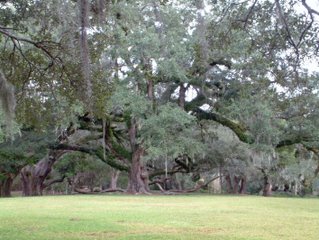 We also visited Avery Island, where tabasco sauce is made. The island, actually the top of a salt dome, has been the home of the McIlhenny family since before the civil war. We toured the factory and sampled some interesting pepper products including my favorite, jalapeno ice cream. We were surprised that it takes so much work to produce those little bottles of Tabasco; I particularly like the fact that they age the pepper sauce in used Jack Daniel's barrels (unfortunately, they grind them clean inside before they use them). It's a beautiful area, with groves of huge live oak and lots and lots of mosquitoes.
After leaving Lafayette, we spent a few forgettable days in Beaumont, Texas, then made the final trip to the refuge. On arrival, we were met by the Brazoria NWR manager with the news that we would be working at Brazoria instead of San Bernard NWR. Both refuges are part of a complex and share people and equipment, and since the RV village is located on Brazoria, it ends up being more convenient for us. We are furnished a pad with full hookups next to a small building with washer/dryer, refrigerator, microwave & TV. We've also been furnished with a government vehicle; a spiffy 99' S-10 Blazer.
We also visited Avery Island, where tabasco sauce is made. The island, actually the top of a salt dome, has been the home of the McIlhenny family since before the civil war. We toured the factory and sampled some interesting pepper products including my favorite, jalapeno ice cream. We were surprised that it takes so much work to produce those little bottles of Tabasco; I particularly like the fact that they age the pepper sauce in used Jack Daniel's barrels (unfortunately, they grind them clean inside before they use them). It's a beautiful area, with groves of huge live oak and lots and lots of mosquitoes.
After leaving Lafayette, we spent a few forgettable days in Beaumont, Texas, then made the final trip to the refuge. On arrival, we were met by the Brazoria NWR manager with the news that we would be working at Brazoria instead of San Bernard NWR. Both refuges are part of a complex and share people and equipment, and since the RV village is located on Brazoria, it ends up being more convenient for us. We are furnished a pad with full hookups next to a small building with washer/dryer, refrigerator, microwave & TV. We've also been furnished with a government vehicle; a spiffy 99' S-10 Blazer.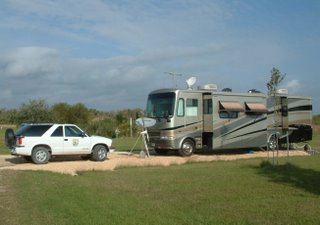 Our three-day workweek is spent in a variety of ways; we staff the visitor ("Discovery") center, I do maintenance work, Brenda works with the office staff, and we both help instruct during Environmental Education days. This is our favorite activity; it starts with the arrival at the Discovery Center of busloads of 4th or 7th grade students which are divided into 8 groups. Refuge staff and volunteers each take turns instructing 8 different subjects at stations located throughout the refuge. The students learn about reptiles while sitting next to a pond with a resident alligator, gather and analyze insect life, tour the refuge with a biologist, and among other subjects, are taught microbiology by Brenda. I work with another volunteer teaching kids about fishing and how to cast. It's a long day and sometimes the kids are a bit unruly, but at the end of the day it's also
Our three-day workweek is spent in a variety of ways; we staff the visitor ("Discovery") center, I do maintenance work, Brenda works with the office staff, and we both help instruct during Environmental Education days. This is our favorite activity; it starts with the arrival at the Discovery Center of busloads of 4th or 7th grade students which are divided into 8 groups. Refuge staff and volunteers each take turns instructing 8 different subjects at stations located throughout the refuge. The students learn about reptiles while sitting next to a pond with a resident alligator, gather and analyze insect life, tour the refuge with a biologist, and among other subjects, are taught microbiology by Brenda. I work with another volunteer teaching kids about fishing and how to cast. It's a long day and sometimes the kids are a bit unruly, but at the end of the day it's also very satisfying.
very satisfying.
 The Brazoria refuge is large, over 44,000 acres, mostly marsh and islands. Migrating waterfowl and birds are starting to arrive; snow geese, ducks, ibis, herons, and roseate spoonbill can be seen almost every day. We're looking forward to the peak later this year when 20,000+ snow geese are expected. The downside of this area is the HUGE number of mosquitoes; they swarm everywhere and going outside, especially after dark, is out of the question. We're also not too crazy about the number of rattlesnakes (seen two), wild pigs (lots of them around), and of course, alligators. But, the weather has been great, sunny and warm, and we're looking forward to exploring the area. Check back with us; we'll tell you of our travels! Thanks for checking on us!
The Brazoria refuge is large, over 44,000 acres, mostly marsh and islands. Migrating waterfowl and birds are starting to arrive; snow geese, ducks, ibis, herons, and roseate spoonbill can be seen almost every day. We're looking forward to the peak later this year when 20,000+ snow geese are expected. The downside of this area is the HUGE number of mosquitoes; they swarm everywhere and going outside, especially after dark, is out of the question. We're also not too crazy about the number of rattlesnakes (seen two), wild pigs (lots of them around), and of course, alligators. But, the weather has been great, sunny and warm, and we're looking forward to exploring the area. Check back with us; we'll tell you of our travels! Thanks for checking on us!

 Well, it's been 30 days and over 3000 miles since we left Montana, and what a great trip we've had. I tried to create a map showing our route but the length and number of places we visited made it too busy to display. To recap our journey so far, we started in Missoula, spent the first night a Billings, then continued on to Wall, SD, where we visited the one and only Wall Drug; a city-block sized building of every piece of tourist junk you can imagine. We counted 47 signs for Wall Drug between Rapid City and Wall, and although how it got there is an interesting story, it didn't live up to the hype. From there, it was off to Sioux City, Davenport, Iowa, Richmond, Indiana, and Spring Valley, outside of Dayton, Ohio. There we visited with our good friends Kirk and Sue Birmeister, other friends in the area, and attended the retirement of Joe and Susan Berube, who were given a great sendoff by friends and family from all over the country. Then it was off to Brunswick, outside of Cleveland, for a visit with Brenda's mom Gladys, sister Joan, brother Ron; my cousin Jayne Kracker, and our friends Sue and Keith Winn. We enjoyed our visit, but it was time to travel again, this time to Johnstown, PA, my first civil service job. We visited with our good friends Pat and Sue Kiniry and drove around looking at all of the changes (mostly good) that have taken place in the area.
Well, it's been 30 days and over 3000 miles since we left Montana, and what a great trip we've had. I tried to create a map showing our route but the length and number of places we visited made it too busy to display. To recap our journey so far, we started in Missoula, spent the first night a Billings, then continued on to Wall, SD, where we visited the one and only Wall Drug; a city-block sized building of every piece of tourist junk you can imagine. We counted 47 signs for Wall Drug between Rapid City and Wall, and although how it got there is an interesting story, it didn't live up to the hype. From there, it was off to Sioux City, Davenport, Iowa, Richmond, Indiana, and Spring Valley, outside of Dayton, Ohio. There we visited with our good friends Kirk and Sue Birmeister, other friends in the area, and attended the retirement of Joe and Susan Berube, who were given a great sendoff by friends and family from all over the country. Then it was off to Brunswick, outside of Cleveland, for a visit with Brenda's mom Gladys, sister Joan, brother Ron; my cousin Jayne Kracker, and our friends Sue and Keith Winn. We enjoyed our visit, but it was time to travel again, this time to Johnstown, PA, my first civil service job. We visited with our good friends Pat and Sue Kiniry and drove around looking at all of the changes (mostly good) that have taken place in the area.
 We stayed at the campground of a dear friend, Grace Shofstall, a lovely place where we kept our RV during our Johnstown days. She's a remarkable woman of indeterminate age who does almost all of the maintenance and upkeep herself, while managing to find the time to create incredible works of art. A real joy to be around, she had us in tears with her story about being addicted to almonds and telling her doctor that she needed to be admitted to a drug and alcohol rehab center. Her park is lovely, and the trees provided a beautiful setting for our stay. Our timing was great for the fall foliage; the leaves were in their peak colors and the weather cooperated for most of our stay. While there, we visited the Flight 93 memorial, a nicely done temporary location in a rural area outside of Somerset.
We stayed at the campground of a dear friend, Grace Shofstall, a lovely place where we kept our RV during our Johnstown days. She's a remarkable woman of indeterminate age who does almost all of the maintenance and upkeep herself, while managing to find the time to create incredible works of art. A real joy to be around, she had us in tears with her story about being addicted to almonds and telling her doctor that she needed to be admitted to a drug and alcohol rehab center. Her park is lovely, and the trees provided a beautiful setting for our stay. Our timing was great for the fall foliage; the leaves were in their peak colors and the weather cooperated for most of our stay. While there, we visited the Flight 93 memorial, a nicely done temporary location in a rural area outside of Somerset.  An amazing number of people find their way on the back roads to reach
An amazing number of people find their way on the back roads to reach the spot where the aircraft impacted. There are plans for a suitable memorial that will be built once funding is available; hopefully in the next year or two. If you double click on the picture, you can see an American flag at the crash site in the field behind the monument.
the spot where the aircraft impacted. There are plans for a suitable memorial that will be built once funding is available; hopefully in the next year or two. If you double click on the picture, you can see an American flag at the crash site in the field behind the monument.  Also in the area is the Quecreek Mine memorial, the site where nine miners were rescued from a flooded underground mine after being trapped for three days. It's amazing to stand on the spot where a shaft was dug to the trapped miner's location 248 feet below; how they were able to locate the miners and drill a 30 inch shaft to pull them out one by one was a truly heroic feat. An interesting web site about the rescue can be found at www.quecreekrescue.org. Leaving western Pennsylvania and land of the hated Steelers, we headed south through West Virginia, Kentucky, Tennessee, and into Red Bay, Alabama, the home of Tiffin Industries and where our Allegro Bay was manufactured. We had hoped to stay at the factory campground and have some minor service done, but all 193 campsites plus 50 overflow sites were taken, so we decided to continue on south and have the work done at a dealer some time in the future. We spent a few days in Natchez, Mississippi, and are currently in Marksville, Louisiana, parked at the Paragon Casino RV park, where Brenda is working on winning us enough money for a new Marathon Coach (they start at $1.2M). We plan on returning to Natchez this weekend to see the annual Hot-Air Balloon Festival and will let you know how our visit went in the next blog. Until then, thanks for checking in on us, and for all of you that we visited in the last month, thanks so much for the great hospitality and for being such great friends!
Also in the area is the Quecreek Mine memorial, the site where nine miners were rescued from a flooded underground mine after being trapped for three days. It's amazing to stand on the spot where a shaft was dug to the trapped miner's location 248 feet below; how they were able to locate the miners and drill a 30 inch shaft to pull them out one by one was a truly heroic feat. An interesting web site about the rescue can be found at www.quecreekrescue.org. Leaving western Pennsylvania and land of the hated Steelers, we headed south through West Virginia, Kentucky, Tennessee, and into Red Bay, Alabama, the home of Tiffin Industries and where our Allegro Bay was manufactured. We had hoped to stay at the factory campground and have some minor service done, but all 193 campsites plus 50 overflow sites were taken, so we decided to continue on south and have the work done at a dealer some time in the future. We spent a few days in Natchez, Mississippi, and are currently in Marksville, Louisiana, parked at the Paragon Casino RV park, where Brenda is working on winning us enough money for a new Marathon Coach (they start at $1.2M). We plan on returning to Natchez this weekend to see the annual Hot-Air Balloon Festival and will let you know how our visit went in the next blog. Until then, thanks for checking in on us, and for all of you that we visited in the last month, thanks so much for the great hospitality and for being such great friends!
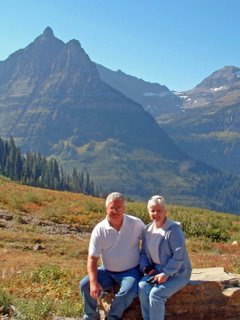 Well, took me long enough to get back to the blog. As many of you know, we've left Montana, visited Dayton, and are now in Brunswick, Ohio visiting Brenda's family. So, journey with me back in time to our visit to Glacier NP........
While in Montana, Glacier was a four to five hour drive away from the refuge, so we decided to wait and spend the better part of a week on a visit. Since around 2 million people visit the park each year, we waited until September 11th so that the kids would be back in school and most of the vacationers would be gone. It turned out to be a good choice, as we found a great RV park with plenty of room, open parking spaces even in the most popular places, and sale prices on all of the tourist trinkets.
Well, took me long enough to get back to the blog. As many of you know, we've left Montana, visited Dayton, and are now in Brunswick, Ohio visiting Brenda's family. So, journey with me back in time to our visit to Glacier NP........
While in Montana, Glacier was a four to five hour drive away from the refuge, so we decided to wait and spend the better part of a week on a visit. Since around 2 million people visit the park each year, we waited until September 11th so that the kids would be back in school and most of the vacationers would be gone. It turned out to be a good choice, as we found a great RV park with plenty of room, open parking spaces even in the most popular places, and sale prices on all of the tourist trinkets.  We've been fortunate to visit many of the big parks; Yosemite, Zion, Bryce Canyon, Grand Canyon, and others, but Glacier was to us, a place apart from the rest due to its size - miles and miles of huge, chiseled mountains and glaciers; with the ability to travel into so many beautiful areas without having to look from a distance. We started our visit on the Going-to-the-Sun
We've been fortunate to visit many of the big parks; Yosemite, Zion, Bryce Canyon, Grand Canyon, and others, but Glacier was to us, a place apart from the rest due to its size - miles and miles of huge, chiseled mountains and glaciers; with the ability to travel into so many beautiful areas without having to look from a distance. We started our visit on the Going-to-the-Sun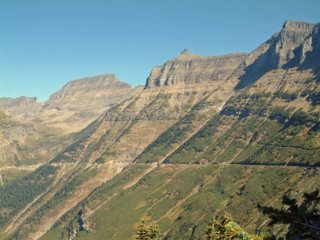 Road, a 50-mile road that hugs the mountains as much as 3000' above the valley. The road winds around curves, is barely two lanes wide, and has only a short rock barrier to separate your vehicle from......space; the final frontier. Brenda enjoyed staring at the floor for most of the trip; she did look down once, babbled something intelligible, then wrapped a floor mat around her head and began to weep. Along the route are stunning vistas of high peaks, lakes, and glaciers. We took a break near the top of the pass where we heard what loud whistles back and forth between the canyon walls - turned out to be Marmots, which look like a groundhog on steroids with beaver teeth.
Road, a 50-mile road that hugs the mountains as much as 3000' above the valley. The road winds around curves, is barely two lanes wide, and has only a short rock barrier to separate your vehicle from......space; the final frontier. Brenda enjoyed staring at the floor for most of the trip; she did look down once, babbled something intelligible, then wrapped a floor mat around her head and began to weep. Along the route are stunning vistas of high peaks, lakes, and glaciers. We took a break near the top of the pass where we heard what loud whistles back and forth between the canyon walls - turned out to be Marmots, which look like a groundhog on steroids with beaver teeth.  At the top of Logan pass is a large visitor center and an area of beautiful alpine meadows stretching off into the distance.
At the top of Logan pass is a large visitor center and an area of beautiful alpine meadows stretching off into the distance. 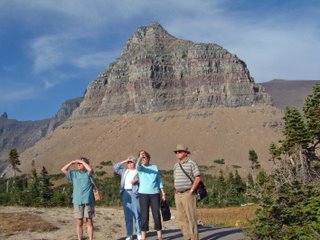 We watched hikers as they made their way to a glacier and lake three miles away; because of the altitude (7000') we decided to pass on the hike and save our energy for shopping. From there, we made our way down the pass, waiting for mountain sheep to move out of a tunnel and off the road, and down to an area of the park called Many Glacier. Here, we had lunch at one of many huge lodges b
We watched hikers as they made their way to a glacier and lake three miles away; because of the altitude (7000') we decided to pass on the hike and save our energy for shopping. From there, we made our way down the pass, waiting for mountain sheep to move out of a tunnel and off the road, and down to an area of the park called Many Glacier. Here, we had lunch at one of many huge lodges b uilt during the early 1900's which stands on the shore of a beautiful lake - sort of looked like the lodge from the movie "The Shining" . Imagine waking up in the morning and seeing the view across the lake. During our time at
uilt during the early 1900's which stands on the shore of a beautiful lake - sort of looked like the lodge from the movie "The Shining" . Imagine waking up in the morning and seeing the view across the lake. During our time at Glacier we drove the backroads looking for wildlife (Brenda's still "mooseless in Montana"), explored the eastern side of the park and contributed money to an Indian casino, and found the best bakery we've had in years at a 50-person village at the end of a 40-mile dirt road. One of our best experiences happened while we had stopped to look at an avalanche path. We heard something coming through the brush, and were amazed to see two black bear, one a juvenile and the other a small cub, climb trees right in front of us to eat berries. The cub didn't seem bothered by us, just ate berries for about 20 minutes and then scurried back into the brush. Apparently mom was around somewhere, but we never saw or heard her. We saw so many incredible sights here that we agreed that we have to come back and spend more time. We hope you've enjoyed sharing our visit to Montana & hope you'll continue to check in with us in the future. Thanks for all the positive feed
Glacier we drove the backroads looking for wildlife (Brenda's still "mooseless in Montana"), explored the eastern side of the park and contributed money to an Indian casino, and found the best bakery we've had in years at a 50-person village at the end of a 40-mile dirt road. One of our best experiences happened while we had stopped to look at an avalanche path. We heard something coming through the brush, and were amazed to see two black bear, one a juvenile and the other a small cub, climb trees right in front of us to eat berries. The cub didn't seem bothered by us, just ate berries for about 20 minutes and then scurried back into the brush. Apparently mom was around somewhere, but we never saw or heard her. We saw so many incredible sights here that we agreed that we have to come back and spend more time. We hope you've enjoyed sharing our visit to Montana & hope you'll continue to check in with us in the future. Thanks for all the positive feed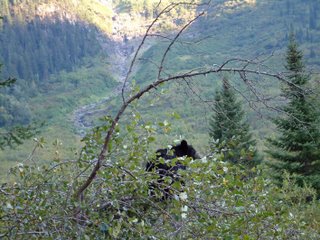 back on the Blog. It was great seeing all of you back in Dayton & we'll be in touch as we continue our adventure!
back on the Blog. It was great seeing all of you back in Dayton & we'll be in touch as we continue our adventure!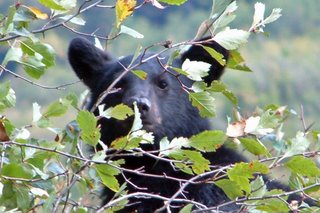
 It's hard to believe, but in two weeks we'll be leaving what has been our home for the past five months - and what a wonderful time it's been! It will be a bittersweet departure; we've made many friends and haven't yet seen all the sights on our list, but also are anxious to get back on the road. Brenda and I have been busy finishing up our refuge projects and getting the motorhome ready for the road. We've arranged the interior and exterior storage areas, waxed the exterior (there's a LOT of paint on this thing), and plotted our route eastbound back to Dayton. We plan on visiting Glacier National Park next week, coming back for the weekend, and then leaving here the 19th for Dayton. We'll spend a week there, travel north to visit Brenda's family in the Cleveland area, head over to Johnstown for a few days to see friends, then head southbound to Texas for our next volunteer adventure. We've been trying to visit some of the places that were on our "must do" list and somewhere see a moose in the wild. Alas, Brenda is still "Mooseless in Montana"; so far I've driven approximately 1600 miles on dirt roads looking for the elusive critter....for all that we've spent on gas we could have bought our own moose by now. But hey, it's the journey, not the destination........our hope is that we'll see a moose or two in Glacier and that the curse of Brenda will finally be lifted. But to catch you up on what we've been doing, here's what we've been up to:
Brenda had to make a quick two-week trip back to be with her mom who had a minor heart attack (although it didn't seem minor at the time). She's doing fine after some rest, which at age 88 is remarkable. Brenda's route back to Missoula was interesting; Cleveland to Phoenix to Seattle to Missoula. The the last leg was on a Dash-8 twin turboprop; it only took two hours to fly 360 miles (must have had a tailwind). Our trip of the week was a 350-mile loop which took us through the Big Hole Valley to the ghost town of Bannack, then through the scenic Pioneer Mountains (the picture above), and finally over Skalkaho pass (too scary to photograph) back to Stevensville. Bannack was an interesting place to visit, it was a short-lived town created in the 1880's by a gold strike. Over 50 buildings still remain, and because of the dry climate and stabilization efforts by a group of volunteers, are in remarkable condition. Some buildings, like the hotel and school, remained in use until the 1950's and 50's, although by then there were just a few area residents. Almost all the buildings were open to explore and some of the buildings
It's hard to believe, but in two weeks we'll be leaving what has been our home for the past five months - and what a wonderful time it's been! It will be a bittersweet departure; we've made many friends and haven't yet seen all the sights on our list, but also are anxious to get back on the road. Brenda and I have been busy finishing up our refuge projects and getting the motorhome ready for the road. We've arranged the interior and exterior storage areas, waxed the exterior (there's a LOT of paint on this thing), and plotted our route eastbound back to Dayton. We plan on visiting Glacier National Park next week, coming back for the weekend, and then leaving here the 19th for Dayton. We'll spend a week there, travel north to visit Brenda's family in the Cleveland area, head over to Johnstown for a few days to see friends, then head southbound to Texas for our next volunteer adventure. We've been trying to visit some of the places that were on our "must do" list and somewhere see a moose in the wild. Alas, Brenda is still "Mooseless in Montana"; so far I've driven approximately 1600 miles on dirt roads looking for the elusive critter....for all that we've spent on gas we could have bought our own moose by now. But hey, it's the journey, not the destination........our hope is that we'll see a moose or two in Glacier and that the curse of Brenda will finally be lifted. But to catch you up on what we've been doing, here's what we've been up to:
Brenda had to make a quick two-week trip back to be with her mom who had a minor heart attack (although it didn't seem minor at the time). She's doing fine after some rest, which at age 88 is remarkable. Brenda's route back to Missoula was interesting; Cleveland to Phoenix to Seattle to Missoula. The the last leg was on a Dash-8 twin turboprop; it only took two hours to fly 360 miles (must have had a tailwind). Our trip of the week was a 350-mile loop which took us through the Big Hole Valley to the ghost town of Bannack, then through the scenic Pioneer Mountains (the picture above), and finally over Skalkaho pass (too scary to photograph) back to Stevensville. Bannack was an interesting place to visit, it was a short-lived town created in the 1880's by a gold strike. Over 50 buildings still remain, and because of the dry climate and stabilization efforts by a group of volunteers, are in remarkable condition. Some buildings, like the hotel and school, remained in use until the 1950's and 50's, although by then there were just a few area residents. Almost all the buildings were open to explore and some of the buildings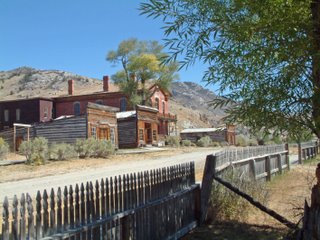 were reputed to be haunted. At one time, Bannack was the territorial capital, although Dillon, which grew larger due to the railroad, took the title until statehood, when Helena became the capital.
were reputed to be haunted. At one time, Bannack was the territorial capital, although Dillon, which grew larger due to the railroad, took the title until statehood, when Helena became the capital.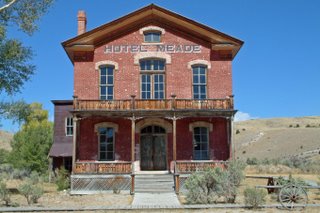 Our trip took us through mountains and
Our trip took us through mountains and 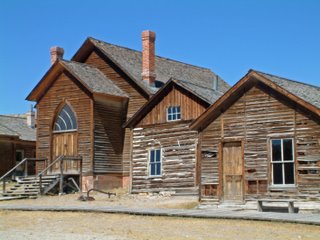 large ranchlands where hundreds of cattle and horses dotted the landscape - what people think of as the "real" Montana. It's also pretty remote; many of the ranches we saw were over 100 miles from the nearest shopping and waaaay farther from a Mall - what a hardship! Our trip back took us over Skalkaho Pass, probably the scariest drive I've ever been on. It's a one-lane dirt road over a 7500' pass without guardrails and sheer dropoffs, some which have to be over 2000'. Not that anything over, say, 200' matters. The real eye-opener is to look back at the road hugging the mountainside and see that the roadbed is eroded underneath and that you were basically driving over a dirt bridge. Yikes.
Our next trip was a bit more conventional; a visit to the US Forest Service Smoke Jumper center at the Missoula Airport. It was an interesting tour of the facilities and explanation of just how crazy these people are. Imagine donning over 100 pounds of parachutes, tools, helmet, ropes, jumpsuit, etc., and then jumping out of a C-47 that saw service during WWII into a remote areas of big, snaggy trees, many of which are on fire. And then, after a 24-hour firefighting shift followed by 16-hour days, gathering up all the stuff you brought and the stuff that was airdropped, putting it into a really big bag, and packing it out on foot to the nearest pickup point. By the way, two weeks in the woods earns you one day off, then you're back on duty. All this for a "seasonal" civil service job at the GS-5/7 level. Bet you can't wait to sign up! Obviously, the folks that do this (many are women) are motivated by some strange desire - thank heaven I never had it.
That's the news for now, time to get busy and sit under the awning & read a good book. Thanks for checking on us!
large ranchlands where hundreds of cattle and horses dotted the landscape - what people think of as the "real" Montana. It's also pretty remote; many of the ranches we saw were over 100 miles from the nearest shopping and waaaay farther from a Mall - what a hardship! Our trip back took us over Skalkaho Pass, probably the scariest drive I've ever been on. It's a one-lane dirt road over a 7500' pass without guardrails and sheer dropoffs, some which have to be over 2000'. Not that anything over, say, 200' matters. The real eye-opener is to look back at the road hugging the mountainside and see that the roadbed is eroded underneath and that you were basically driving over a dirt bridge. Yikes.
Our next trip was a bit more conventional; a visit to the US Forest Service Smoke Jumper center at the Missoula Airport. It was an interesting tour of the facilities and explanation of just how crazy these people are. Imagine donning over 100 pounds of parachutes, tools, helmet, ropes, jumpsuit, etc., and then jumping out of a C-47 that saw service during WWII into a remote areas of big, snaggy trees, many of which are on fire. And then, after a 24-hour firefighting shift followed by 16-hour days, gathering up all the stuff you brought and the stuff that was airdropped, putting it into a really big bag, and packing it out on foot to the nearest pickup point. By the way, two weeks in the woods earns you one day off, then you're back on duty. All this for a "seasonal" civil service job at the GS-5/7 level. Bet you can't wait to sign up! Obviously, the folks that do this (many are women) are motivated by some strange desire - thank heaven I never had it.
That's the news for now, time to get busy and sit under the awning & read a good book. Thanks for checking on us!
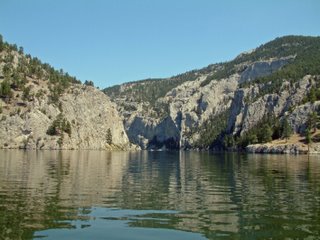 Twenty miles North of Helena along the interstate is an interesting geological formation known as the "Gates of the Mountains". In July 1807, as the Lewis and Clark expedition was working its way up the Missouri River along the rolling plains, they came to the place where the Rocky Mountains abruptly begin. From a distance, the river seems to disappear into the rock; only when you approach can you see where the river enters the tall cliffs, hence the description by Meriwether Lewis that this place was the "Gates of the Rocky Mountains". Today a downriver dam has created a lake and deep channel through the area and Brenda and I, along with our fellow fulltimer friends Dennis and Ann, boarded a tour boat for a two-hour tour (where have I heard that before?). With an entertaining tour guide/captain, blue skies, and calm water, we entered the "gates" and began our tour. The sheer canyon walls rise as much as 1200' on either side of river and in many areas were heavily forested. We saw eagles and an unusual cliffside osprey nest with fledglings, who watched us as we motored by.
Twenty miles North of Helena along the interstate is an interesting geological formation known as the "Gates of the Mountains". In July 1807, as the Lewis and Clark expedition was working its way up the Missouri River along the rolling plains, they came to the place where the Rocky Mountains abruptly begin. From a distance, the river seems to disappear into the rock; only when you approach can you see where the river enters the tall cliffs, hence the description by Meriwether Lewis that this place was the "Gates of the Rocky Mountains". Today a downriver dam has created a lake and deep channel through the area and Brenda and I, along with our fellow fulltimer friends Dennis and Ann, boarded a tour boat for a two-hour tour (where have I heard that before?). With an entertaining tour guide/captain, blue skies, and calm water, we entered the "gates" and began our tour. The sheer canyon walls rise as much as 1200' on either side of river and in many areas were heavily forested. We saw eagles and an unusual cliffside osprey nest with fledglings, who watched us as we motored by.  A real treat was seeing a
A real treat was seeing a river otter family with two pups; they seemed curious and entertained us with their play until the parents decided it was time to move on. We continued down the river to Mann Gulch, the site of a tragic wildfire in 1949 where 13 firefighters, the majority "smoke jumpers" were killed.
river otter family with two pups; they seemed curious and entertained us with their play until the parents decided it was time to move on. We continued down the river to Mann Gulch, the site of a tragic wildfire in 1949 where 13 firefighters, the majority "smoke jumpers" were killed.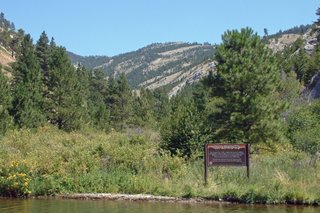
 It's a fascinating story of one of the first recorded "blowups", a phenomenon that creates a tornado-like fire which is estimated at Mann Gulch fire to have burned over 2000 acres in less than two minutes. Only three smoke jumpers survived; two young men who managed to outrun the fire and the foreman who amazingly made the decision to build an escape fire once he realized he could not outrun the flames. He set an area of brush on fire, laid down with a wet cloth over his face, and let the fire race over him. He later said that the fire picked him up and threw him down three times, yet he survived without injury. The event is described in a riveting book, "Young Men and Fire" written by Norman Maclean, who also wrote "A River Runs Through It". Near the gulch and accessible only by boat is a beautiful memorial and picnic area. The tour guide did a great job of describing the sequence of events and made it easy to visualize how the fire developed. A good synopsis of the fire is on a US Forest Service web site at www.fs.fed.us/rm/pubs/int_gtr299/.
Turning back downriver, our guide pointed out an arch located high on the mountainside, and later an interesting formation called "rhino rock" for obvious reasons.
It's a fascinating story of one of the first recorded "blowups", a phenomenon that creates a tornado-like fire which is estimated at Mann Gulch fire to have burned over 2000 acres in less than two minutes. Only three smoke jumpers survived; two young men who managed to outrun the fire and the foreman who amazingly made the decision to build an escape fire once he realized he could not outrun the flames. He set an area of brush on fire, laid down with a wet cloth over his face, and let the fire race over him. He later said that the fire picked him up and threw him down three times, yet he survived without injury. The event is described in a riveting book, "Young Men and Fire" written by Norman Maclean, who also wrote "A River Runs Through It". Near the gulch and accessible only by boat is a beautiful memorial and picnic area. The tour guide did a great job of describing the sequence of events and made it easy to visualize how the fire developed. A good synopsis of the fire is on a US Forest Service web site at www.fs.fed.us/rm/pubs/int_gtr299/.
Turning back downriver, our guide pointed out an arch located high on the mountainside, and later an interesting formation called "rhino rock" for obvious reasons.
 Finally, as we neared the dock we saw probably the most unusual sight of the day.......check out the boat with the hound hood ornament. He was having a ball; ears flapping and baying - we all enjoyed the show!
Finally, as we neared the dock we saw probably the most unusual sight of the day.......check out the boat with the hound hood ornament. He was having a ball; ears flapping and baying - we all enjoyed the show! 
Wow - time has gone by so fast! I just realized it's been almost a month since our last post. We've become so involved in activities here at the refuge that it's almost like working for a living again....except that it's fun and our work is always appreciated. We're just getting over an unusual hot spell; almost two weeks of high 90's and four days over 100, a new Missoula record for July. Even though the days were hot, each night cooled off as soon as the sun set, and most mornings it was in the high 50's. Now, we're finally back to normal - mid 80's during the day and cool nights (this morning was 47 and we had to turn the heat on). Unfortunately, the heat has created a tremendous wildfire potential. It's difficult for us to believe how quickly the area went from raging rivers and snow-covered mountains to such dry conditions. An article in the local paper was interesting; when the moisture content of dead timber was measured last week, it was 12%. Kiln-dried lumber is 8%, a startling indication on just how dry the forest has become. It didn't take long for the fires to start; first in the mountains to our Southwest about 12 miles, then quickly another in the mountains 10 miles Northeast. ........the next day another fire to our Northwest.
........the next day another fire to our Northwest.
 The first one is still burning; the rugged terrain has limited the use of aerial tankers and it's grown to over 2000 acres. The other two have been pretty much controlled, although the fire to our Northeast destroyed three homes. Everyone's apprehensive that if thunderstorms develop in the mountains we could see fires throughout the state on the level of the 2000 season, the worst on record. On our "road trips" we frequently see the burned areas from that horrible year......miles and miles of burned trees in areas that will take 20 years to recover. We're in no danger here in the valley, but are keeping our fingers crossed that it will be a quiet fire season.
The first one is still burning; the rugged terrain has limited the use of aerial tankers and it's grown to over 2000 acres. The other two have been pretty much controlled, although the fire to our Northeast destroyed three homes. Everyone's apprehensive that if thunderstorms develop in the mountains we could see fires throughout the state on the level of the 2000 season, the worst on record. On our "road trips" we frequently see the burned areas from that horrible year......miles and miles of burned trees in areas that will take 20 years to recover. We're in no danger here in the valley, but are keeping our fingers crossed that it will be a quiet fire season.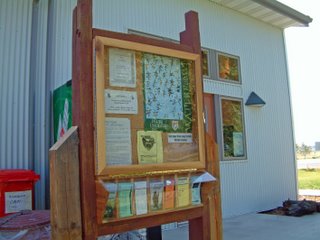 We've both been churning out products for the staff here along with staffing the visitor center. Brenda has been busy authoring a volunteer guide and updating the bird banding data base while I've been building an information kiosk, painting and patching, and doing other odd jobs to help out. We feel as though we're part of the refuge family after these three and a half months and it will be hard to say goodbye to all the friends we made when we leave in September. But that's what this lifestyle is all about, meeting new people and making new friends while exploring new areas.
We've both been churning out products for the staff here along with staffing the visitor center. Brenda has been busy authoring a volunteer guide and updating the bird banding data base while I've been building an information kiosk, painting and patching, and doing other odd jobs to help out. We feel as though we're part of the refuge family after these three and a half months and it will be hard to say goodbye to all the friends we made when we leave in September. But that's what this lifestyle is all about, meeting new people and making new friends while exploring new areas.
We both had reached our limit of tolerance with the Jeep; poor mileage, noisy ride, and back-breaking seats might be fine for those in their 20's, but it finally became too much for us. After much looking and research, we settled on a Mazda Tribute, a small SUV with 4 wheel drive and lots of interior room. We're very pleased so far, it's comfortable, gets good mileage, and we'll have room to carry more stuff when we travel. One review called it the "Miata of small SUVs" because of it's quick handling. I attempted to confirm this by taking a 90-degree corner at high speed, but Brenda's screaming was a huge distraction so I'm not sure........but it's a LOT better than the Jeep.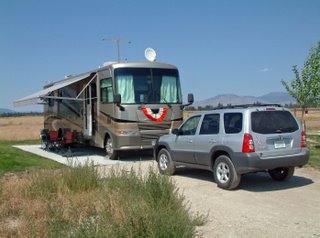 Another upgrade for us is the arrival of Dennis and Ann Boyce, a couple that we met in Tucson this spring and who have become great friends. They came to visit for a week or two and now we've talked them into staying for two months as fellow workampers. They're great folks and have jumped right in as if they've been here for years. Dennis is retired Army but I'm considering forgiving him since he joined at a young age and probably didn't know any better since he's from Minnesota where there aren't any Air Force bases. Thanks again for checking on us, hope you're all enjoying the summer as much as we are!
Another upgrade for us is the arrival of Dennis and Ann Boyce, a couple that we met in Tucson this spring and who have become great friends. They came to visit for a week or two and now we've talked them into staying for two months as fellow workampers. They're great folks and have jumped right in as if they've been here for years. Dennis is retired Army but I'm considering forgiving him since he joined at a young age and probably didn't know any better since he's from Minnesota where there aren't any Air Force bases. Thanks again for checking on us, hope you're all enjoying the summer as much as we are!
In my pre working-at-a-wildlife-refuge days, I thought that "bird banding" was some type of avian instrumental group - imagine my surprise to find out they actually put little metal bands on birds! Last week Brenda and I had the opportunity to visit and watch while refuge staff and volunteers conducted bird banding. 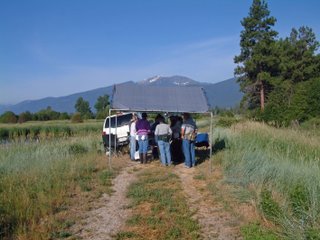 The banding takes place on the Lee Metcalf refuge and has been ongoing at the same site for over 10 years. I have to admit I grumbled about having to get up at the crack of dawn (7:00 AM), but she pointed out that the volunteers conducting the banding started at 5:00 AM, so I grudgingly agreed.
The banding takes place on the Lee Metcalf refuge and has been ongoing at the same site for over 10 years. I have to admit I grumbled about having to get up at the crack of dawn (7:00 AM), but she pointed out that the volunteers conducting the banding started at 5:00 AM, so I grudgingly agreed.
The birds are captured using a series of very fine, large rectangular nets, called "mist" nets, placed in the same position each week during the season so that the data collected has a baseline. 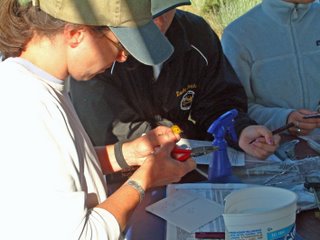 Birds that have flown into the net (about 60 during a six-hour period) are placed in a soft cloth bag & taken to the banding station. We were both impressed on the thoroughness of the data that is compiled on each bird; weight, body dimensions, approximate age, and overall health are recorded, and a feather or two is taken for analysis. One of the more intricate tasks is to take a swab sample from the birds errr.........afterburner. The samples are sent to UCLA where they study the transmittal of avian viruses (harmless & which all birds have) in the hope of learning more about how "bird flu" may be transmitted if it mutates to become a danger to humans.
Birds that have flown into the net (about 60 during a six-hour period) are placed in a soft cloth bag & taken to the banding station. We were both impressed on the thoroughness of the data that is compiled on each bird; weight, body dimensions, approximate age, and overall health are recorded, and a feather or two is taken for analysis. One of the more intricate tasks is to take a swab sample from the birds errr.........afterburner. The samples are sent to UCLA where they study the transmittal of avian viruses (harmless & which all birds have) in the hope of learning more about how "bird flu" may be transmitted if it mutates to become a danger to humans.  The birds were handled very carefully, and we learned that if they showed signs of stress (don't ask me how they can tell), they were immediately released, or if they had a large brood patch (a fatty area on the stomach that covers the eggs) they were quickly banded and let go to return to their nest. Seeing the birds up close was eye-opening; some of them, like the Bullocks's Oriole, Cedar Waxwing, and the little Yellow Warbler were incredibly beautiful up close.
The birds were handled very carefully, and we learned that if they showed signs of stress (don't ask me how they can tell), they were immediately released, or if they had a large brood patch (a fatty area on the stomach that covers the eggs) they were quickly banded and let go to return to their nest. Seeing the birds up close was eye-opening; some of them, like the Bullocks's Oriole, Cedar Waxwing, and the little Yellow Warbler were incredibly beautiful up close. 
 The highlight of Brenda's day was holding and releasing the Cedar Waxwing, although it didn't seem to appreciate her efforts as it kept biting her finger.
The highlight of Brenda's day was holding and releasing the Cedar Waxwing, although it didn't seem to appreciate her efforts as it kept biting her finger. 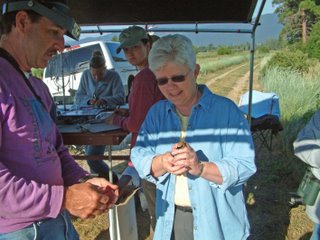 Her form in the release was perfect, sorta like when she pitches horseshoes. For me, as someone who's only previous bird interest
Her form in the release was perfect, sorta like when she pitches horseshoes. For me, as someone who's only previous bird interest was how many and what size impacted an aircraft, this was an enlightening and enjoyable experience. By the way, I asked the biologist what the largest animal captured in the net was; you guessed it - a moose. Unfortunately, the temporarily captured moose took the net, the poles, and a 1/4 acre of dirt with him as he ambled off. Of course, Brenda wasn't there to see it, she's still "mooseless in Montana". Well, we're off for a sightseeing drive in search of the big bovine, so until next time, thanks for checking on us!
was how many and what size impacted an aircraft, this was an enlightening and enjoyable experience. By the way, I asked the biologist what the largest animal captured in the net was; you guessed it - a moose. Unfortunately, the temporarily captured moose took the net, the poles, and a 1/4 acre of dirt with him as he ambled off. Of course, Brenda wasn't there to see it, she's still "mooseless in Montana". Well, we're off for a sightseeing drive in search of the big bovine, so until next time, thanks for checking on us!
 Since the perimeter wall is the same size as the Alamo's was, (about a city block) it's easy to see how it would be impossible to defend with less than 300 men. We thought it interesting that a Catholic mission, still in use, is managed by the US Park Service, a government agency. Also interesting was the granary, a reproduction of the original water-driven mill.
Since the perimeter wall is the same size as the Alamo's was, (about a city block) it's easy to see how it would be impossible to defend with less than 300 men. We thought it interesting that a Catholic mission, still in use, is managed by the US Park Service, a government agency. Also interesting was the granary, a reproduction of the original water-driven mill.  The Spanish missionaries and soldiers would not eat corn flour, so the mill only ground wheat for their bread, and the millstones (still in use) were imported from France. So we end up with a stone from France grinding wheat for their enemy the Spanish in a country where everyone eats corn.
The Spanish missionaries and soldiers would not eat corn flour, so the mill only ground wheat for their bread, and the millstones (still in use) were imported from France. So we end up with a stone from France grinding wheat for their enemy the Spanish in a country where everyone eats corn. been to. It helped that it was a marvelous day, high 70s and sunny; and with everyone else out shopping we had the place to ourselves.
been to. It helped that it was a marvelous day, high 70s and sunny; and with everyone else out shopping we had the place to ourselves. 


















































